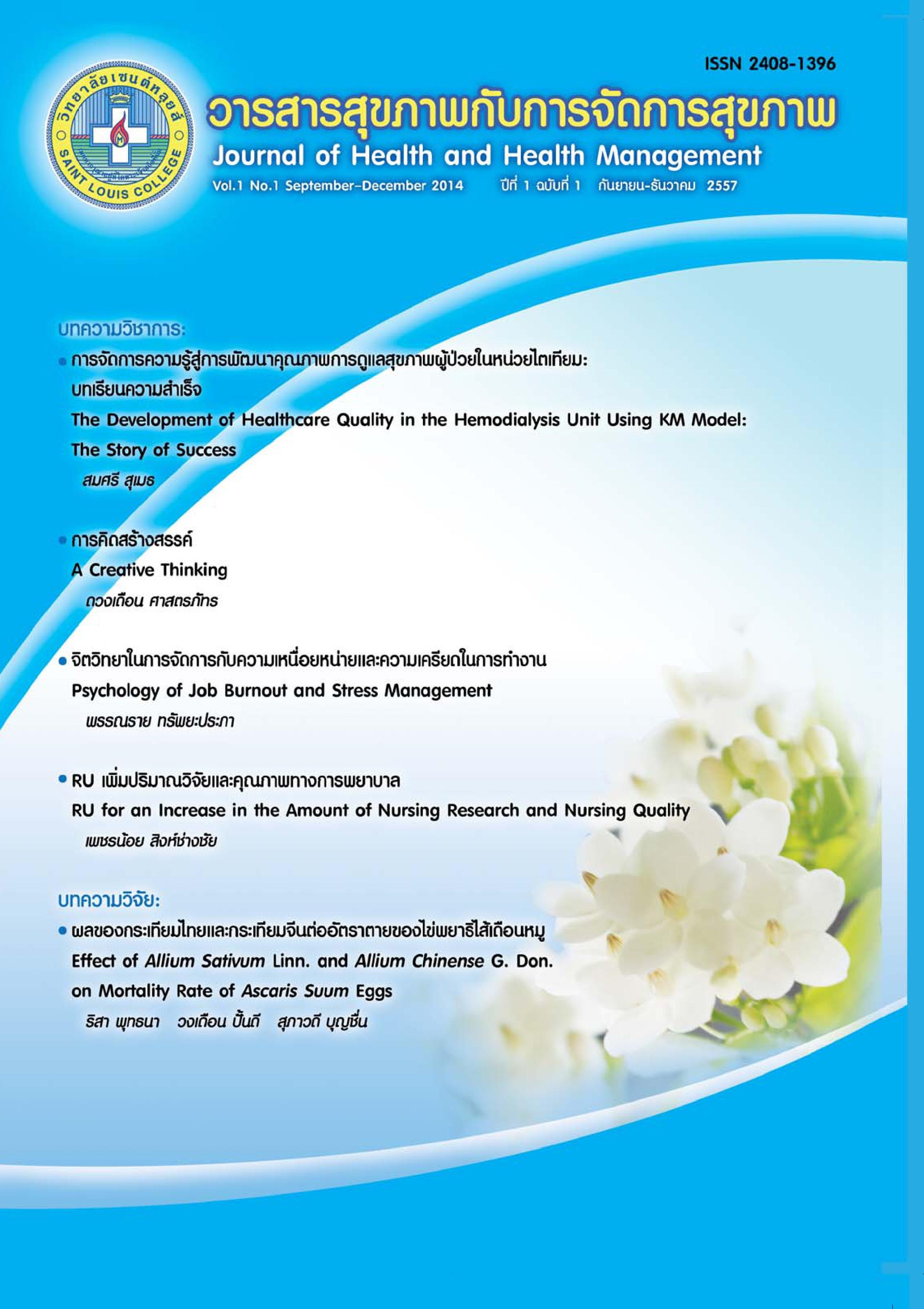A Creative Thinking
Keywords:
thinking process, creative thinking, psychologyAbstract
Creative thinking means the thought process that leads to innovation, problem solving, or synthesis on various subjects, invention of useful, valuable and appropriate products. Joy Paul Guilford identified creative thinking as a kind of divergent thinking, rather than convergent thinking. Edward de Bono and Hamid Ebrahimzadeh Rajaei viewed creative thinking as thinking out of the box. According to the Arthur Leonard Schawlow, a factor that distinguishes scientists who are highly creative from low creative ones, is motivation, especially the curiosity, driven to pursue research for answers. Perspectives of creative features consist of cognition, personality and social, neurobiology, mental health, creativity and intelligence. Critical theories of creativity include Componential, Psychoanalytic and Humanistic theories. Creativity is measured by various concepts including the concepts of creativity quotient, psychometric approach, personality and social approach. In addition, two researches were presented, entitled “Developing young children’s creative writing ability in English as a second language in a Primary English Medium School in Karachi, Pakistan” and “Promoting innovative learning network of teachers and educators to develop students thinking skills. Phase 2 in Ubon Ratchathani.”
References
อารี หลวงนา และคณะ. (2553). การส่งเสริมนวัตกรรม เครือข่ายการเรียนรู้ของครูและบุคลากรทาง การศึกษาเพื่อพัฒนาคุณภาพผู้เรียนด้านทักษะ การคิดในจังหวัดอุบลราชธานี ระยะที่ 2 คณะครุศาสตร์ มหาวิทยาลัยราชภัฎอุบลราชธานี (รายงานผลการวิจัย). อุบลราชธานี: มหาวิทยาลัยราชภัฎอุบลราชธานี.
Akello, K.J. (2005). Developing young children’s creative writing ability in English as a second language in a Primary English Medium School in Karachi, Pakistan (Master’s dissertation, Aga Khan University, Karachi, Pakistan). Retrieved from http://ecommons.aku.edu/theses_ dissertations/276/
Batey, M. & Furnham, A. (2006). Creativity, intelligence and personality: A critical review of the scattered literature. Genetic, Social, and General Psychology Monographs,132, pp. 355-429.
Baron, F. (1969). Creative person and creative process. New York: Holt, Rinehart & Winston.
Boden, M.A. (2004). The creative mind: Myths and mechanisms (2nd ed.). New York : Routled.
Dacey, J. (1999). Concepts of creativity: A history. In M.A. Runco and S.R. Pritzer. Encyclopedia of Creativity, Vol. I. Elsevier.
De Bono, E. (1970). Lateral thinking: creativity step by step. New York: Harper & Row.
Feist, G. J. (1998). A meta-analysis of the impact of personality on scientific and artistic creativity. Personality and Social Psychological Review, 2, pp. 290-309.
Finke, R., Ward, T.B. & Smith, S. M. (1992). Creative cognition: Theory, research, and applications. Cambridge, MA : MIT Press.
Flaherty, A.W. (2005). Frototemporal and dopaminergic control of idea generation and creative drive. J Comp Neurol, 493(1), pp. 147–53.
Furnham, A., Batey, M., Anand, K. & Manfield, J. (2008). Personality, hypomania, intelligence and creativity. Personality and Individual Differences, 44, pp. 1060-1069.
Gladwell, M. (2008). Outliers: The Story of Success. New York: Little, Brown and Company.
Guilford, J.P. (1950). Creativity. American Psychologist, 5 (9), pp. 444–454.
Guilford, J.P. (1967). The nature of human intelligence. New York: McGraw-Hill.Rajaei, H.E. (n.d.). The concept of creativity. Retrieved from https://www.academia. edu/5526802/The_concept_of_creativity
Helmholtz, H. v. L. (1896). Vorträge und Reden (5th ed.). Friederich Vieweg und Sohn.
Jamison, Kay Redfield. (1993). Touched with fire: Manic-depressive illness and the artistic temperament. New York: The Free Press.
Heilman, K.M., Nadeau, S.E. & Beversdorf, D.Q. (2003). Creative innovation: Possible brain mechanisms. Neurocase. Retrieved from http://neurology.med.ohio-state.edu/ cognitivelab/CreativityMechanisms. pdf
Phillips, J. M., & Gully, S. M. (2011). Organizational behavior: Tools for success. Mason, OH: South-Western/ Cengage Learning.
Phillips, J. M., & Gully, S. M. (2012). Organizational behavior: Tools for success (1st ed.). South-Western/ Cengage Learning
Poincaré, H. (1908/1952). Mathematical creation. In B. Ghiselin (Ed.), The Creative process: A symposium. Mentor. New York.
Stephen. (2014). Theory of Creative Process. Ripper design and multimedia. Retrieved from www.ripperdesignandmultimedia. com/category/theory-of-creativity/ Published March 27, 2014 /By Stephen.
Roberts, M. (2012). Creativity ‘closely entwined with mental illness. Retrieved from http://www.bbc.co.uk/news/ health-19959565. 16 October 2012.
Royal Thai Embassy, Washington D.C., Office of Science and Technology. (2012). การศึกษาความสัมพันธ์ระหว่างความคิด สร้างสรรค์กับอาการป่วยทางจิต. Retrieved from http://www.ostc.thaiembdc.org/test2012/ stnews_Nov12_3
Runco, M.A. (2007). Creativity: Theories and themes: Research, development, and practice. London: Elsevier Academic Press.
Runco, M.A. & Albert, R. S. (2010). Creativity research. In J.C. Kaufman and R.J. Sternberg. The Cambridge handbook of creativity. Cambridge University Press.
Schawlow, A. (1982, Fall). Going for the gaps. Stanford Magazine, p. 42.
Sternberg, R.J. (2001). What is the common thread of creativity? American Psychologist, 56, pp. 360-362. Sternberg, R.J., & Lubart, T.I. (1995). Defying the crowd: Cultivating creativity in a culture of conformity. New York: Free Press.
Torrance, E.P. (1974). Torrance tests of creative thinking. Bensenville, IL: Scholastic Testing Service, Inc.
Wallach, M.A. and Kogan, N. (1965). Modes of thinking in your children: A study of the creativity-intelligence distinction. New York: Holt, Rinerhart & Winston.
Wallas, G. (1926). The art of thought. New York: Harcourt Brace and World. Weisberg, R. W. (1993). Creativity: Beyond the myth of genius. New York: W.H. Freeman.




